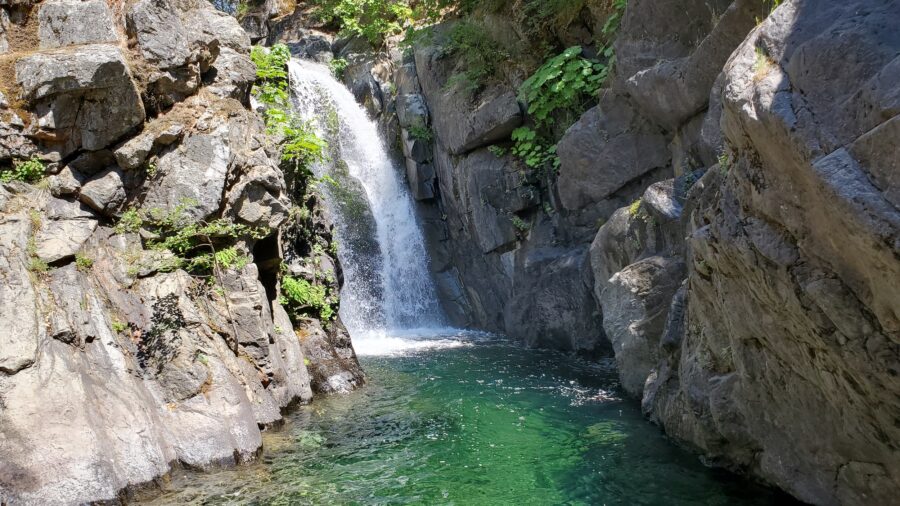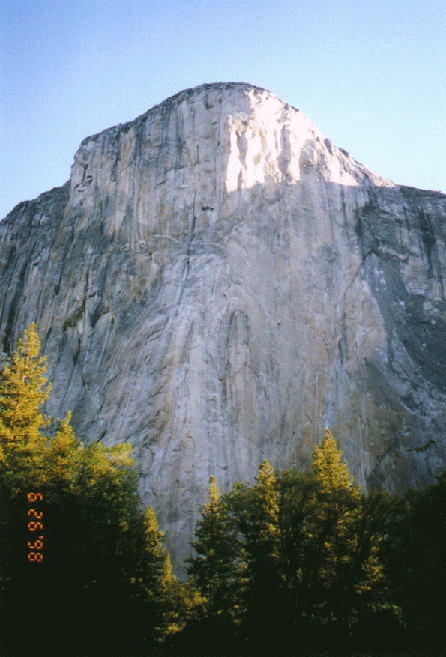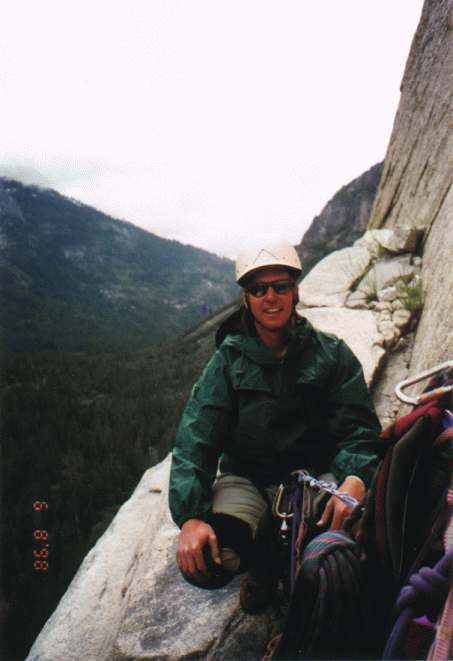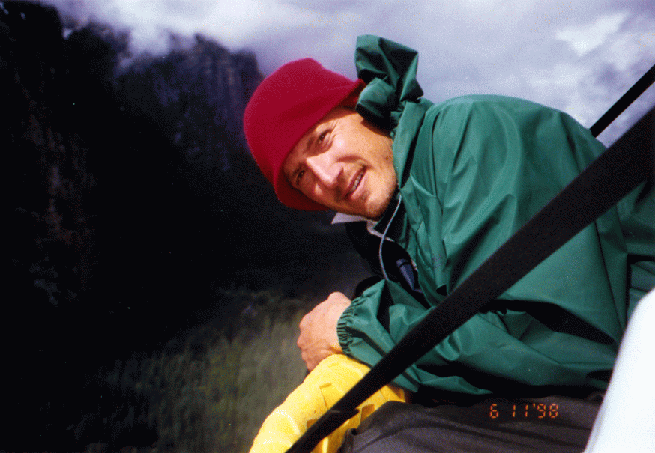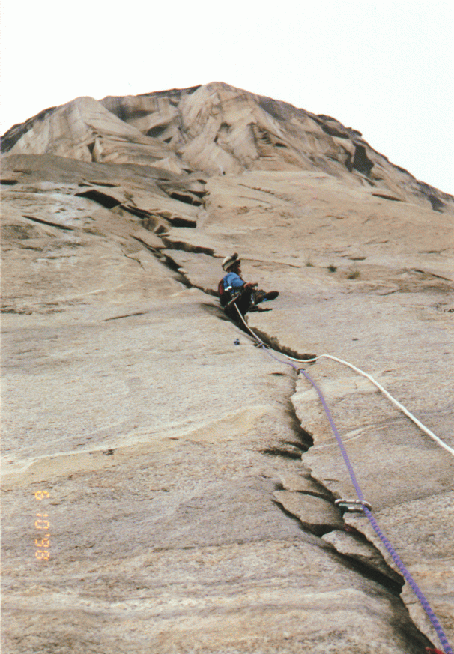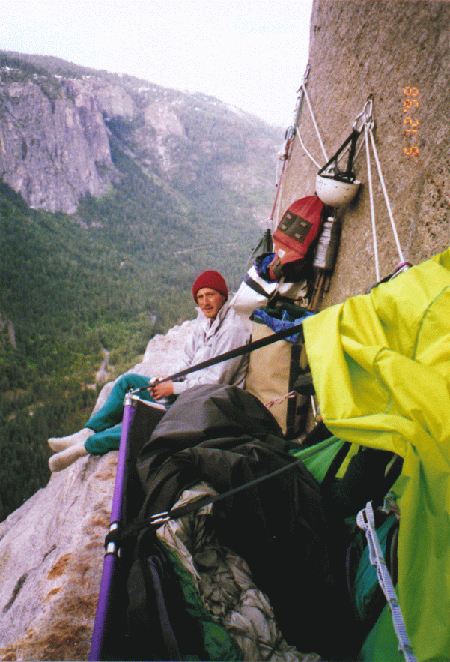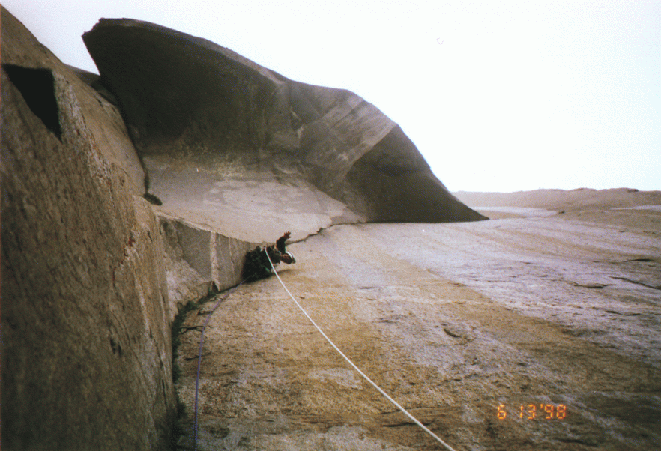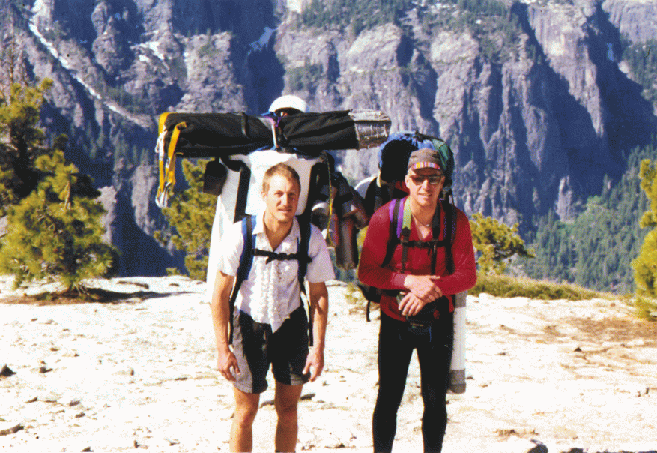In June of ’98 my brother Chris and I climbed The Nose route on El Capitan in Yosemite National Park, California. While this is probably the easiest route up El Cap it still is 3000 feet and 34 pitches of climbing. The climbing is not too difficult, but hauling 130 pounds of food, gear and water is a lot of work.
While The Nose has been climbed in an incredible 4 hours and 22 minutes, and was recently free-climbed by Lynn Hill in less than 24 hours, we had no intentions of trying to set any records. In fact, because of two rainstorms we took almost 4 days and 22 hours. We spent 4 nights on the wall in our portaledge.
We fixed ropes on the first 4 pitches to Sickle Ledge and hauled our pig up before taking a day off. Unfortunately, that rest day was a sunny day. We were only on the second pitch of the Stovelegs (pitch 9) on the first day of climbing before it started raining hard. Clearing and Warmer was the forecast, so we were quite suprised by a very hard rain before noon. We setup our portaledge in the middle of the Stovelegs (so named because the original pitons used to protect this 450′ crack were constructed from the legs of a stove) and waited out this storm for 24 hours.
What did we do for 24 hours on a 4’x6′ platform 900 feet in the air? I don’t really know, but we had the topo of the route memorized by the time we finished. I remember continually saying that this is June in CA and the dominant weather pattern is high pressure with bomber blue sky. This can’t last for long.
During that first night we heard a party rappelling down in the wet darkness, from way up high. We think they were at Camp 5, which is more than 2000′ up. Why were they rapping? They had obviously withstood rain in the previous days?
We finally got moving the next day a little after noon and nobody else had started climbing the route. We had two friends from Eugene, Dru and Bruce, who had hauled their pig above Sickle the previous day who we expected to start climbing. Why didn’t they start? Had they heard an updated weather forecast that was bad? We climbed only 6 pitches that second day to the best ledge on the route, El Cap Towers. This was where we had planned to bivy the first night. Bivying on a ledge allows for much better organization and thus (hopefully) quicker starts in the morning.
The third day we awoke to sunshine and got a late start hanging out enjoying the sunshine. Chris had to climb the Texas Flake Chimney (5.8 with little protection) and wasn’t eager to get an early start. Besides, we were already climbing slow and the sun and the ledge felt pretty damn good.
The skies quickly darkened again and by early afternoon it was raining again and Chris got wet on the final lead of the day – again. We were almost to Camp 4 when we set up the portaledge and warmed up (pitch 19). This time only 17 hours waiting. Again we had a party rappel past us from above. These guys were on a different route and had run out of food after 5 days. Now there was nobody else above us and the whole El Cap was eerily empty except we heard Bruce and Dru down on Dolt Tower (pitch 12). They were aiming for El Cap Towers, but since they were at a decent ledge they bivied early and luckily missed the hardest rain.
The 4th day we climbed past the most amazing and recognizable feature on the route, the Great Roof. I would have tried to free it, but it was oozing green slimey wetness. Lynn Hill is the only person to have free climbed this pitch and it was strange to think about trying to free it. I guess the rating is something like 5.13b, but no man has been able to do it because the crack is too small. Lynn is my hero. The rest of us mortals aid climb the roof on mostly fixed gear and otherwise bomber protection. We bivied above the Pancake Flake just before Camp 5 and one pitch after the Great Roof. We were delayed at the pitch before the roof, which is a 5.9 free face climb, because it was totally wet. Turns out our bivy above the Pancake Flake was a much better bivy even though there wasn’t a good ledge. We had awesome exposure where we were (2000 feet up) and Camp 5 didn’t smell too good as somebody had abandoned some food and their poop bucket and it was rotting.
Day 5 was the first day of solid weather and we started climbing at 6:30am and were determined to get off the wall. We reached the final bolt ladder just at dark and then topped out about 10:30pm or so.
We climbed 10 mostly aid pitches that day and were quite tired. But the last pitch is really cool. It is a bolt ladder of maybe 30 shiney 3/8 bolts, obviously replaced since Warren Harding’s ascent. It is the first overhanging pitch and the whole route hangs below you. When the haulbag is released it swings out about 15 feet with 3000 feet of air below. Quite awesome. It wasn’t scary because the bolts were so bomber, but if they were the original 1/4″ rusty guys that would have been one damn scary pitch. We bivied on the top of the summit after scrambling another 500 vertical feet to this tree that I just had to find. Dru and Bruce topped out just after we did and we all bivied together on the summit.
The next morning was another bomber blue sky day and it was a brutal 8 mile hike down. The first 5 miles were in deep snow and the last 3 down the Yosemite Falls trail were brutal with the haulbags. Next time we do the East Ledges Rappel.
Overall, it was pretty satisfying to finally get up the thing, especially considering the weather we had to endure. This was the third time we had tried to climb it. The first time we got to Sickle Ledge and came down because of weather. Last year, Chris got injured on The Leaning Tower and thus we never got started on The Nose. That is probably why we were so willing to stay up there in the rain. Even with several parties rapping past us and basically being by ourselves on the whole El Cap we continued to inch our way up. We had lots of food and water and were probably ready to spend 7-8 days if needed. I was a bit bummed that I wasn’t able to free more because the route was so wet and I look forward to doing it again much faster. But we learned a lot about storms on big walls and understand how much water can be running down the crack you’re climbing. Since there is no place for the water to go but down the wall, there are huge waterfalls all over the wall. If you are bivied in one of those or are climbing in one you will get absolutely hammered with water. We had read about that, but not experienced it.
Craig Thornley
June 1998
For more info on Yosemite climbing or The Nose, check out:
